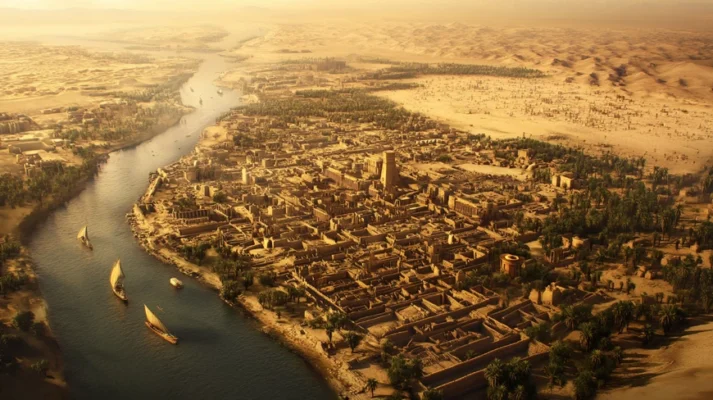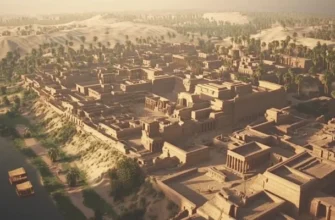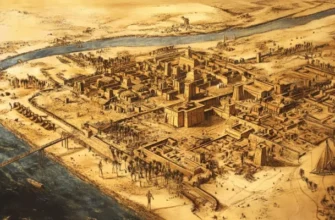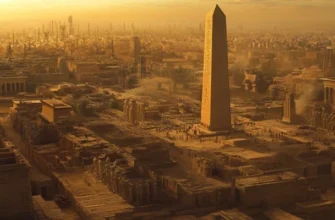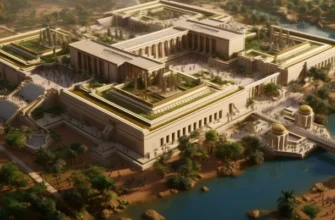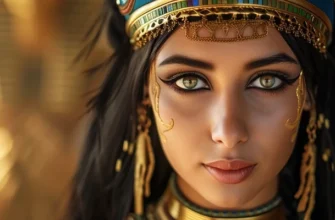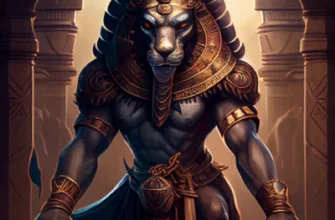Tanis (D’Janet in Egyptian) is one of the key cities of ancient Egypt, which played an important role in the history and culture of this ancient world. Located in the eastern part of the Nile Delta, Tanis was a political and religious center, especially during the Third Transitional Period and the late Egyptian period.
The city was founded during the New Kingdom, but Tanis reached its heyday in the 21st and 22nd dynasties, when it became the capital of Egypt. Due to its strategic location near the Mediterranean Sea and important trade routes, Tanis was a center of international trade and political relations.
Majestic temples dedicated to the gods Amun, Mut, and Khonsu were built in Tanis, emphasizing its religious significance. The city was even called the “second Valley of the Kings” because of the unique burials of the pharaohs that were found during archaeological excavations.
Tanis is known for its grandiose finds, including the golden mask of Pharaoh Psusennes I, numerous treasures and artifacts. Thanks to this, the city became one of the key archaeological sites of Ancient Egypt.
Today Tanis is an archaeological park that attracts researchers and tourists. Its ruins are a reminder of the greatness of the ancient civilization and its contribution to world culture.
Tanis remains an important symbol of the power and spirituality of ancient Egypt.
- Geographical location and importance of Tanis
- The city’s role in trade and politics
- History of Tanis
- Archaeological finds in Tanis
- Tombs of the pharaohs and the “second Valley of the Kings”
- Temples and monumental buildings
- Known structures that have been preserved or discovered.
- Religious and cultural significance of Tanis
- Religious significance
- Temples of the main gods of the city
- The current state of Tanis
- Conclusion
Geographical location and importance of Tanis
Tanis, or D’Janet, is located in the eastern part of the Nile Delta, in the northeast of modern Egypt, near the Mediterranean Sea. Its strategic location at the crossroads of river and land trade routes made the city an important economic and political center.
Tanis was located near the main transportation arteries that connected Egypt with the Mediterranean regions, the Middle East, and Africa. This allowed it to play the role of an important port and trade hub. In addition, its proximity to military routes made Tanis strategically important for the country’s defense.
Due to its location, Tanis became the capital of Egypt during the reigns of the pharaohs of the 21st and 22nd dynasties. It was a political center that helped strengthen control over the Nile Delta.
The city was also of great religious importance. There were temples dedicated to the gods Amun, Mut, and Khonsu, which attracted pilgrims from all over Egypt. The majestic monumental buildings and temples in Tanis testified to its importance in the spiritual life of the country.
Thus, the geographical location of Tanis determined its importance as an economic, political, and religious center, leaving a deep mark on ancient Egyptian history.
The city’s role in trade and politics
Tanis was one of the key centers of ancient Egypt, playing a significant role in trade and politics. Its location in the eastern part of the Nile Delta, near the Mediterranean Sea, made it an important hub between Egypt and other regions such as the Levant, Asia, and Africa.
Trade
Tanis was an important port through which goods from the Mediterranean, the Middle East, and Nubia passed. Thanks to its position, it became an intermediary in the trade of raw materials, jewelry, wood, metals, fabrics, and other valuable goods.
The fertile lands of the Nile Delta allowed Tanis to play an important role in supplying grain to both the domestic market and neighboring states. This strengthened its economic position and contributed to prosperity.
Politics
During the 21st and 22nd dynasties, Tanis was the political capital of Egypt. It was ruled by pharaohs who controlled the lower part of the country. The city became a symbol of power and an administrative center in a period of political instability.
Its proximity to the eastern borders made Tanis an important defense point. The city served as a base for military campaigns in the Levant and also protected Egypt from external invasions.
Tanis was a place where agreements were concluded and political contacts were maintained with neighboring states. Thanks to trade and military power, the city played an important role in strengthening Egyptian power in the region.
Developed trade and strategic location made Tanis not only an economic center, but also a key player in the political life of ancient Egypt. Its influence extended far beyond the borders of the country, contributing to the strengthening of the power of Egyptian civilization.
History of Tanis
Tanis, known in ancient Egyptian as D’Janet, was one of the most important cities in ancient Egypt. Its history encompasses periods of prosperity, decline, and discovery that have made it a key site in the study of ancient civilization.
Founding and early development
Tanis was founded during the New Kingdom (circa 13th century BC) and gradually gained importance due to its location in the Nile Delta. This allowed the city to serve as a trade hub between Egypt and neighboring regions, as well as to control strategic waterways.
The city became a cultural and religious center, where majestic temples were built, including those dedicated to the god Amun.
The heyday: the capital of Egypt
After the collapse of centralized power in the New Kingdom, Tanis became the capital of Egypt during the reigns of the 21st and 22nd dynasties (ca. 1070-715 BC).
21st Dynasty
Tanis became the administrative center of Lower Egypt. The pharaohs of this dynasty, such as Psusennes I, built tombs and temples in the city that rivaled the famous temples of Thebes in grandeur.
The 22nd Dynasty
During the reign of the Libyan pharaohs, the city remained the political capital and an important military outpost. Tanis actively interacted with neighboring states, strengthening Egypt’s foreign policy ties.
Decline of Tanis
After the 22nd Dynasty, the city gradually lost its importance due to changing geopolitical conditions and the transfer of the administrative center to other cities, including Memphis and Alexandria. Salinization of the soil due to changes in the Nile’s course also contributed to the decline of its economic role.
By the Ptolemaic period, Tanis had become a minor city and gradually declined, turning into a local center.
The real interest in Tanis was renewed in the 19th and 20th centuries thanks to archaeological excavations. In 1939, the French archaeologist Pierre Monte found the tombs of the pharaohs of Tanis filled with golden treasures, including the famous golden mask of Psusennes I.
These discoveries confirmed the importance of Tanis as a religious and political center, as well as its role as the “second Valley of the Kings.”
The history of Tanis reflects the ups and downs of the power of ancient Egypt. It witnessed the flourishing of culture, the greatness of pharaohs, and the decline of civilization. Today, Tanis remains an archaeological gem that reveals the mysteries of ancient history. The role of Tanis in different epochs of Egyptian history.
Archaeological finds in Tanis
Tanis, one of the most important archaeological sites of Ancient Egypt, has been the site of many discoveries that have shed light on its majestic past. Excavations in this city have uncovered numerous artifacts, pharaohs’ tombs, and monumental structures that confirm its importance as a religious, political, and cultural center.
Tombs of the pharaohs and the “second Valley of the Kings”
In 1939, the French archaeologist Pierre Monte discovered the tombs of the pharaohs in Tanis, which are often compared to the tombs of the Valley of the Kings in Thebes. The pharaohs of the 21st and 22nd dynasties, in particular, were buried here:
Psusennes I: His tomb was strikingly rich, and the pharaoh’s golden mask was one of the most outstanding finds.
Amenemopet and Sheshonk II: Their tombs also contained unique treasures, including jewelry and funerary objects.
Unlike the Valley of the Kings, the tombs of Tanis were not looted, which allowed many artifacts to be preserved in their original form.
Tanis has gained a reputation as the “second Valley of the Kings” due to the impressive tombs of the pharaohs that have been found during archaeological excavations. Unlike the famous Valley of the Kings in Thebes, the tombs of Tanis are not located in rocky gorges, but under the city’s temple complex. They have been preserved in a relatively intact condition, which made it possible to find numerous treasures and artifacts.
The tombs of the pharaohs of Tanis are located under the temples, which distinguishes them from the West Thebes tombs. This provided them with better protection from robbers, as the underground tombs were hidden under massive slabs and temple structures.
Pharaohs buried in Tanis
The rulers of the 21st and 22nd dynasties were buried in the city, including:
Psusennes I: His tomb contained luxurious treasures, including the famous golden mask.
Amenemopet: Tomb of the pharaoh with a large amount of jewelry.
Sheshonk II: A sarcophagus made of silver, as well as numerous jewelry and weapons.
Materials of the tombs
A feature of Tanis tombs was the use of rare materials:
Sarcophagi were made not only of stone but also of silver, which was more valuable than gold in ancient Egypt.
Gold jewelry and ritual objects created with exquisite craftsmanship.
Due to their isolated location and changes in the Nile’s course, the tombs of Tanis were not plundered in ancient times, which is rare for Egyptian burials.
Treasures of the tombs of Tanis
The tombs of Tanis are striking in their wealth of finds:
The golden mask of Psusennes I: One of the finest examples of Egyptian art, comparable to the famous mask of Tutankhamun.
Silver and electrum sarcophagi: Unique to ancient Egypt.
Jewelry: Tiaras, bracelets, necklaces inlaid with precious stones.
Ritual objects: Scepters, amulets, vessels for funeral gifts.
Temples and monumental buildings
Tanis was home to majestic temples built in honor of the main Egyptian gods. The most famous are:
The Temple of Amun: One of the largest religious complexes in the city, decorated with majestic statues and obelisks.
Temples of Mut and Khonsu: They complemented the cult architecture of Tanis, emphasizing its religious significance.
Many of the stone blocks and statues in the Tanis temples come from earlier structures, particularly from Per Ramses, indicating the reuse of materials.
Finds from Tanis tombs and temples include:
The golden mask of Psusennes I: A masterpiece of ancient Egyptian art made of pure gold.
Sarcophagi and funerary objects: Made of precious materials such as silver, electrum, and stone.
Jewelry: Jewelry encrusted with precious stones that emphasized the skill of Egyptian artisans.
Excavations in Tanis have confirmed its status as an important religious center. Unique tombs and treasures have revealed new aspects of the culture and funerary traditions of the late period of Ancient Egypt.
Today, Tanis is an archaeological park where excavations and conservation work are underway. Its findings are kept in museums around the world, including the Cairo Museum, and attract researchers and tourists.
The findings at Tanis have become an invaluable source for understanding the history of ancient Egypt and preserving its cultural heritage.
The discovery of the tombs in Tanis by the French archaeologist Pierre Monte in 1939 was a real sensation. It expanded the understanding of the funerary traditions of the late Egyptian period and confirmed Tanis’ status as a political and religious center.
Archaeological research has shown that, despite its distance from the Valley of the Kings in Thebes, Tanis continued the tradition of the lavish burial of pharaohs. The city’s treasures have been preserved in the Cairo Museum and other world collections, leaving Tanis as a symbol of the wealth and greatness of ancient Egyptian civilization.
Thanks to its unique tombs and riches, Tanis is deservedly called the “second Valley of the Kings”. This place has become an invaluable source for the study of Egyptian history and culture, confirming the city’s role as one of the most important centers of the late period of Ancient Egypt. H3: Discoveries by archaeologists
Known structures that have been preserved or discovered.
Archaeological excavations in Tanis have uncovered numerous majestic structures that testify to its religious, political, and architectural importance. Below are the most famous structures that have survived or been discovered:
- Temple of Amun
The largest religious complex in Tanis, dedicated to the main god Amun.
It is known for its scale and monumentality: huge columns, obelisks, and statues reminiscent of the architecture of the temples in Thebes.
The stones for the construction of the temple were partially brought from Per Ramses, which indicates the reuse of materials.
- Temple of the goddess Mut
The second most important temple in the city, dedicated to the wife of Amun.
Located near the Temple of Amun, it was part of the Tanis religious ensemble.
Remains of decorative elements and statues of the goddess were found in the temple.
- Honsu Temple
A small but important temple dedicated to the son of Amun and Mut, the moon god Khonsu.
The architectural style repeats the main features of other religious buildings in Tanis.
- Tombs of the pharaohs
Unique tombs of the pharaohs of the 21st and 22nd dynasties, including Psusennes I, Amenemopet, and Sheshonk II.
The peculiarity of these tombs is the use of silver sarcophagi, which was rare even for ancient Egypt.
The tombs were covered with massive stone slabs to protect them from robbers.
- Monumental obelisks
Obelisks with grandiose inscriptions that emphasized the greatness of the rulers and religious traditions of Tanis.
Many of them are decorated with hieroglyphs that tell of the pharaohs’ victories and their piety.
- Statues of pharaohs and gods
Numerous statues have been found, including large colossi, depicting the pharaohs in their divine roles.
Some of the statues have been destroyed, but the remains allow us to appreciate their majesty.
These structures reflect the wealth and power of Tanis as a religious and administrative center. Their architectural style and size testify to the pharaohs’ desire to demonstrate their greatness and secure the support of the gods.
Today, many of these structures are available for exploration, preserving the memory of the heyday of ancient Egypt.
Religious and cultural significance of Tanis
Tanis was not only a political but also a religious and cultural center of Ancient Egypt. Its role in the worship of gods, ritual practices, and preservation of cultural heritage testifies to the special place of this city in the history of Egyptian civilization.
Religious significance
The cult of Amun
Tanis became one of the main centers of worship of the god Amun, who was considered the patron saint of the pharaohs and the main god of the Egyptian pantheon.
A grandiose Temple of Amun was built in the city, which served as a venue for rituals and festivals that glorified the divine nature of the pharaohs.
Amun was revered as the city’s main protector, and the temple became a key religious center in the Nile Delta.
The cult triad of Tanis
The religious life of the city centered around a triad of gods:
Amun was the main god, a symbol of power and authority.
Mut is Amun’s wife, the personification of motherhood and protection.
Khonsu is the son of Amun, the god of the moon.
All three deities had their own temples in Tanis, where regular rituals were held.
Holidays and rituals
Tanis celebrated major religious festivals, such as the festival of Opet, during which the gods “visited” each other in processions.
Sacrifices were made to ensure the stability of the state and protection from enemies.
The center of temple architecture
Tanis was known for its monumental architecture, including temples, obelisks, and statues. These structures not only had religious significance but also demonstrated Egypt’s artistic and technological progress.
Tanis was a center of jewelry art.
Finds from the tombs, such as the golden mask of Psusennes I, demonstrate the sophistication of the work of ancient Egyptian craftsmen.
The silver and electrum items found in the tombs are rare examples of the material culture of the time.
As a major administrative center, Tanis was a place where important texts, including religious and legal documents, were created and stored.
Due to its location, Tanis served as a bridge between Egypt and neighboring regions. The city had contacts with the Levant, Cyprus, and other civilizations, which facilitated cultural exchange.
Tanis served as an important symbol of the divine origin of the pharaohs’ power. The city’s temples emphasized the rulers’ connection to the gods and their role as guarantors of stability and prosperity.
The religious and cultural significance of Tanis went far beyond the city itself. It was a spiritual center, a place where art, religion, and politics interacted, which had a great influence on the development of Egyptian civilization. Tanis became the embodiment of the richness of the culture and religious heritage of Ancient Egypt.
Temples of the main gods of the city
Tanis was home to majestic temples dedicated to the main gods, who played a central role in the religious life of the city. These shrines were not only cult centers but also symbols of the political power of the pharaohs, who maintained the divine order.
- Temple of Amun
The main temple of Tanis, dedicated to the god Amun, who was the central deity of the Egyptian pantheon.
Known for its scale and architectural scope, the temple was similar in style and significance to the Temple of Amun in Karnataka.
Features of the temple:
Columns decorated with hieroglyphs glorifying Amun and the pharaohs.
Large statues, obelisks and monumental gates.
Materials for the construction, including stones, were brought from Per-Ramses, the previous capital.
The temple served as a venue for the most important religious festivals, such as processions in honor of Amun.
- The Temple of Mut
Dedicated to the goddess Mut, the wife of Amun, who symbolized motherhood and protection.
The Mut Temple was part of the Tanis temple complex and was located near the Temple of Amun.
Architectural features:
Altars and statues that emphasized the divine essence of the goddess.
Decorative elements depicting Mut as a woman with the double crown of Egypt.
- Temple of Honsu
Dedicated to Khonsu, the son of Amun and Mut, the moon god who personified the night sky and the protection of travelers.
The temple was smaller in size than the temples of Amun and Mut, but it was important for the religious life of the city.
Features of the temple:
The image of Hongsu as a young god with a moon disk above his head.
The interiors are decorated with scenes of religious rituals and ceremonies.
- Other religious buildings
Tanis also had small chapels and temples dedicated to local and regional deities that supported the main pantheon.
The statues and remains of obelisks found indicate an active religious life and numerous rituals.
The temples at Tanis were centers of worship where important religious rites, sacrifices, and celebrations were held.
The construction and maintenance of the temples emphasized the power of the pharaohs, who acted as intermediaries between the gods and the people.
The temples served as a place of preservation of art and crafts that reflected the high skill of ancient Egyptian architects and sculptors.
The temples of the main gods of Tanis – Amun, Mut, and Khonsu – were not only religious buildings but also symbols of the city’s power and grandeur. Their architecture and the treasures found during excavations provide insight into the spiritual and cultural life of ancient Egypt, making Tanis one of the pearls of the history of this civilization. H3: Cultural heritage of Tanis
The current state of Tanis
Tanis, one of the most important cities of Ancient Egypt, is a significant archaeological site today. Although the city has long since lost its former importance, its ruins remain a valuable source for studying the history, culture, and religion of ancient Egyptian civilization.
Ruins of temples and buildings
The remains of temples, in particular, have been preserved on the site of ancient Tanis:
Fragments of the Temple of Amun with destroyed columns and obelisks.
Ruins of the temples of Mut and Khonsu.
Individual stone blocks and statues left over from monumental structures.
Tombs of the pharaohs
The tombs of the 21st and 22nd dynasties are one of the main attractions.
Although most of the treasures and artifacts have been moved to museums, the tombs themselves are open to the public.
Modern archaeological activities
Excavations are regularly conducted in Tanis to study the remains of the city and discover new artifacts.
Archaeologists explore both religious buildings and residential areas to better understand the daily life of the ancient Egyptians.
Museum exhibits from Tanis
Most of the finds from Tanis are now stored in museums, including:
Egyptian Museum in Cairo:
The golden mask of Psusennes I.
Silver sarcophagi, jewelry, and funerary objects.
Problems of conservation
Erosion and the influence of time
The ruins of Tanis have suffered greatly from climate change, soil salinization, and the movement of the Nile riverbed.
Some of the monuments have lost their integrity due to poor storage conditions.
Current threats
Human activity and lack of proper control have caused some damage to the sites.
The need for restoration work to preserve the ruins is becoming increasingly urgent.
Tourism and popularization
Tanis attracts lovers of archeology and history, although the tourist flow is not yet as large as to other Egyptian sites.
Excursions to the site of the archaeological park allow you to get acquainted with the ruins of temples and tombs.
Tanis is mentioned in scientific works, documentaries, and popular culture, which contributes to its popularity.
The Egyptian government, together with international organizations, is working on projects to preserve and popularize Tanis:
Modern Tanis is an archaeological treasure trove that continues to reveal the secrets of ancient Egypt. Despite the influence of time, it remains an important object of research and popularization of Egyptian heritage, as well as an attractive place for tourists and scholars. How Tanis attracts tourists and researchers.
Conclusion
Tanis is a unique monument of Ancient Egypt that reflects the greatness, wealth, and cultural heritage of one of the world’s oldest civilizations. As the political capital of the pharaohs of the 21st and 22nd dynasties, Tanis was a center of power, religion, and trade, and its temples and tombs demonstrate the high skill of Egyptian architects and craftsmen.
The discovery of Tanis’ tombs, including the pristine tombs of the pharaohs with magnificent treasures, was a sensation for archaeology, confirming its status as the “second Valley of the Kings.” These finds not only enrich knowledge about the funerary traditions of ancient Egypt, but also reveal the intricacies of art, religion, and life of the society of that time.
Today, Tanis is an important object of research and preservation that attracts archaeologists and tourists, and serves as a symbol of Egypt’s cultural heritage. Its significance in world history and archeology cannot be overestimated – Tanis remains a vivid example of the power and heritage of an ancient civilization that continues to inspire and open up new horizons of knowledge.
